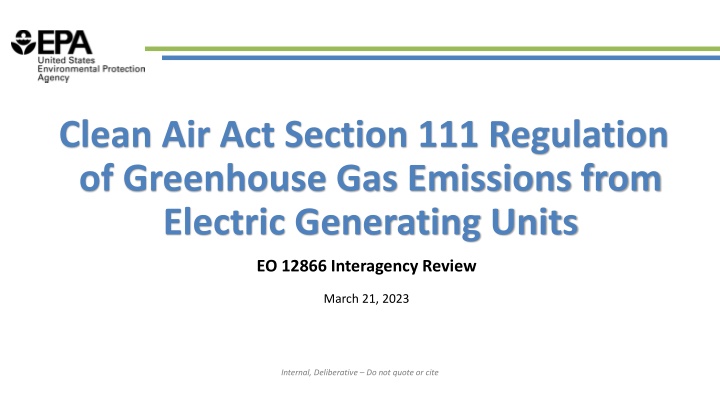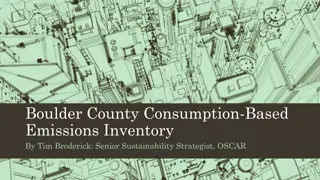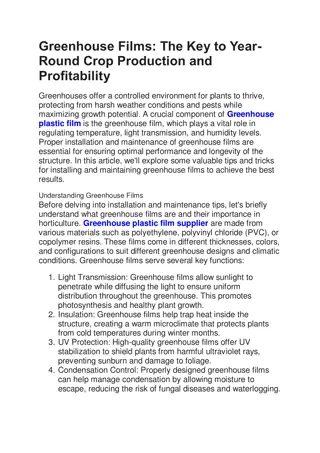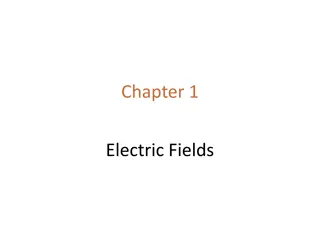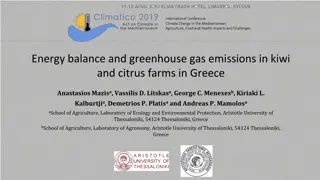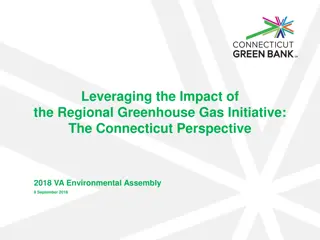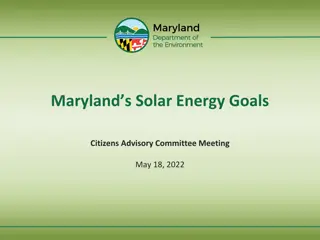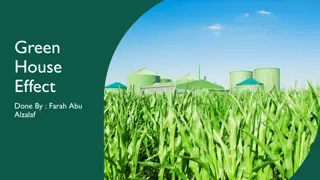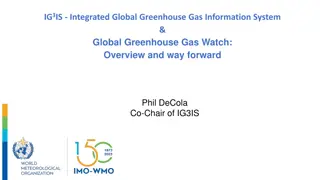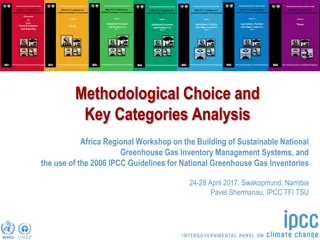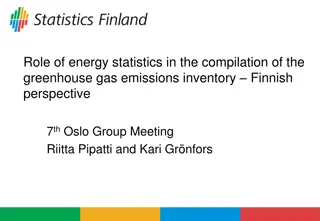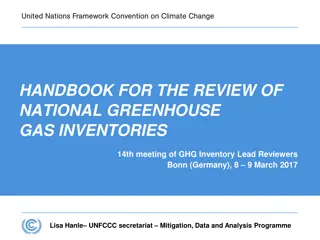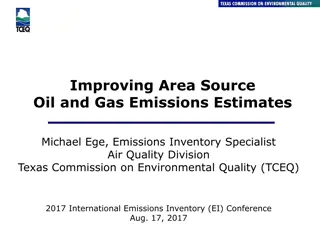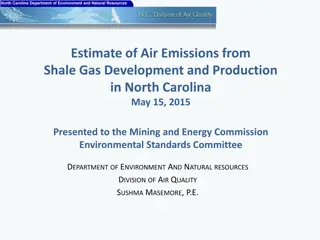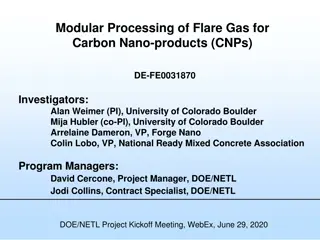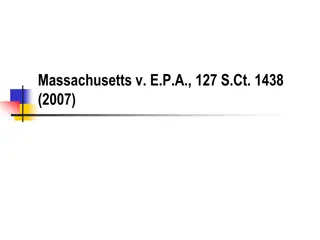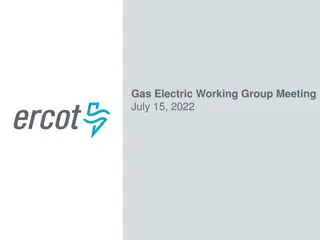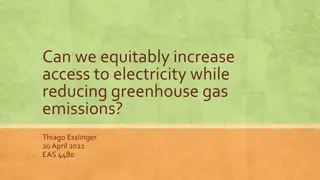Regulation of Greenhouse Gas Emissions from Electric Generating Units
This document outlines the regulatory history of the Clean Air Act Section 111, including the establishment of greenhouse gas standards, emission guidelines, and the development of performance standards and state plans. It provides insights into the NSPS for stationary combustion turbines and details the requirements for different subcategories of turbines. The document also highlights the BSER and standards for low load peaking units under the NSPS for stationary combustion turbines.
Download Presentation

Please find below an Image/Link to download the presentation.
The content on the website is provided AS IS for your information and personal use only. It may not be sold, licensed, or shared on other websites without obtaining consent from the author.If you encounter any issues during the download, it is possible that the publisher has removed the file from their server.
You are allowed to download the files provided on this website for personal or commercial use, subject to the condition that they are used lawfully. All files are the property of their respective owners.
The content on the website is provided AS IS for your information and personal use only. It may not be sold, licensed, or shared on other websites without obtaining consent from the author.
E N D
Presentation Transcript
Clean Air Act Section 111 Regulation of Greenhouse Gas Emissions from Electric Generating Units EO 12866 Interagency Review March 21, 2023 Internal, Deliberative Do not quote or cite
Outline Regulatory History Overview of Proposed Requirements New Source Performance Standards (NSPS) Emission Guidelines State Plan Development Repeal of the Affordable Clean Energy (ACE) Rule Summary of Cost, Environmental, and Economic Impacts 2 Internal, Deliberative Do not quote or cite
Regulatory History NSPS; CAA 111(b) In 2015, the EPA established greenhouse gas (GHG) standards for fossil fuel-fired steam generating units and fossil fuel-fired stationary combustion turbines In 2018, the EPA proposed to revise the NSPS but never finalized the proposal Emission Guidelines; CAA 111(d) In 2015, the EPA finalized the Clean Power Plan (CPP) to address GHGs from existing electric generating units (EGUs) In 2019, the EPA repealed and replaced the CPP with the ACE rule In 2021, the D.C. Circuit Court vacated the ACE rule, which included the CPP repeal In 2022, the Supreme Court reversed the vacatur of the ACE rule and upheld the CPP Repeal 3 Internal, Deliberative Do not quote or cite
NSPS Stationary Combustion Turbines Applicability date for NSPS is the date of proposal 40 CFR part 60, subpart TTTT (steam generating units and stationary combustion turbines) 40 CFR part 60, subpart TTTTa (stationary combustion turbines) 4 Internal, Deliberative Do not quote or cite
NSPS Stationary Combustion Turbines Three general subcategories of stationary combustion turbines Low load peaking turbines Intermediate load turbines Base load turbines 5 Internal, Deliberative Do not quote or cite
NSPS Stationary Combustion Turbines Low load peaking units BSER and standards: BSER: clean fuels Standards of performance: 120 160 lb CO2/MMBtu (depending on the clean fuel used) Intermediate load combustion turbines: BSER has two components to be implemented in 2 phases: o 1st component of BSER: Highly efficient generation o 2nd component of BSER: Co-firing 30% (by volume) low-GHG hydrogen Phases: o 1st phase standards of performance: 1,150 lb CO2 /MWh-gross based on performance of a highly efficient natural gas-fired simple cycle turbine o 2nd phase standards of performance : 1,000 lb CO2 /MWh-gross based on performance of a highly efficient natural gas-fired simple cycle turbine co-firing 30% (by volume) low-GHG hydrogen o Standards would be higher for combustion turbines burning non-natural gas fuels with higher emission rates on a lb CO2/MMBtu basis 6 Internal, Deliberative Do not quote or cite
NSPS Stationary Combustion Turbines Base load combustion turbines: 2 components to be implemented in 2 phases: o 1st component of BSER: Highly efficient generation o 2nd component of BSER: Either co-firing 30% (by volume) low-GHG hydrogen or 90% carbon capture and storage (CCS) 1st phase standard of performance: 770 900 lb CO2 /MWh-gross, depending on the base load rating based on the performance of a highly efficient natural gas-fired combined cycle combustion turbine o Standard is higher for combustion turbines burning non-natural gas fuels with higher emission rates on a lb CO2/MMBtu basis 2nd phase standards: o Base load units combusting less than 10% hydrogen: 90 100 lb CO2 /MWh-gross, depending on the base load rating based on the performance of a highly efficient natural gas-fired combined cycle combustion turbine implementing 90% CCS o Base load units combusting more than 10% hydrogen: 680 lb CO2 /MWh-gross based on the performance of a highly efficient natural gas-fired combined cycle combustion turbine co-firing 30% (by volume) low-GHG hydrogen o Standard is higher for combustion turbines burning non-natural gas fuels with higher emission rates on a lb CO2/MMBtu basis 7 Internal, Deliberative Do not quote or cite
Emission Guidelines Steam Generating Units Existing fossil fuel-fired steam generating units proposing emission guidelines covering these sources Existing fossil fuel-fired stationary combustion turbines soliciting comment on emission guidelines covering these sources Applicability follows from NSPS, includes coverage of sources in non-continental and non-contiguous states and territories 8 Internal, Deliberative Do not quote or cite
Emission Guidelines Subcategories Proposes four subcategories for existing fossil fuel-fired steam generating EGUs, based on the operating horizon of the unit Long-term EGUs Units that have no commitment to cease operations prior to January 1, 2040 Medium-term EGUs Units that have a binding commitment to cease operations prior to January 1, 2040 Near-term EGUs Units that have a binding commitment to cease operations prior to January 1, 2035, annual capacity factor less than 20 percent Imminent-term EGUs Units that have a binding commitment to cease operations prior to January 1, 2032 9 Internal, Deliberative Do not quote or cite
Emission Guidelines BSER and Degree of Emission Limitation Long-term Coal-fired Steam Generating Units BSER: Carbon capture and storage with 90% CO2 capture Emission limitation: 88.4% reduction in emission rate Medium-term Coal-fired Steam Generating Units BSER: co-firing 40% (by heat input) natural gas Emission limitation: 16% reduction in emission rate Imminent-term and Near-term Coal-fired Steam Generating Units BSER: Routine methods of operation and maintenance Emission limitation: no increase in emission rate (presumptive standard of a unit- specific baseline) 10 Internal, Deliberative Do not quote or cite
Emission Guidelines Natural Gas-fired Steam Generating Units Low load: < 8% annual capacity factor BSER: None proposed, taking comment on a clean fuels BSER and presumptive standards on a heat input basis (i.e., 120 lb CO2/MMBtu) Intermediate load: 8-to-45% annual capacity factor BSER: Routine O&M Emission limitation: no increase in emission rate a presumptive standard of 1,500 lb CO2/MWh-gross Base load: 45% annual capacity factor BSER: Routine O&M Emission limitation: no increase in emission rate a presumptive standard of 1,300 lb CO2/MWh-gross 11 Internal, Deliberative Do not quote or cite
Emission Guidelines Oil-fired Steam Generating Units Low load: < 8% annual capacity factor BSER: None proposed, taking comment on a clean fuels BSER and presumptive standards on a heat input basis (i.e., 160 lb CO2/MMBtu) Intermediate load (continental): 8-to-45% annual capacity factor BSER: Routine O&M Emission limitation: no increase in emission rate (presumptive standard of 1,500 lb CO2/MWh- gross) Base load (continental): 45% annual capacity factor BSER: Routine O&M Emission limitation: no increase in emission rate (presumptive standard of 1,300 lb CO2/MWh- gross) Intermediate and base load (non-continental): BSER: Routine O&M Emission limitation: no increase in emission rate (presumptive standard of a unit-specific baseline) 12 Internal, Deliberative Do not quote or cite
Emission Guidelines Existing Combustion Turbines EPA has an obligation to regulate GHG emissions existing combustion turbines because it has established NSPS for new combustion turbines EPA intends to fulfill that obligation as expeditiously as practicable, and as an initial step, is soliciting comments to inform the development of emission guidelines This action solicits comment on a potential staged approach in which an initial rulemaking would address the most frequently operated units and a later subsequent rulemaking would address the remaining units The first stage would focus on frequently operated turbines (e.g., capacity factor of greater than 50% -60%) and would focus on ... a BSER of CCS on a subset of these units and; a BSER of heat rate (efficiency) improvements for the other units This approach recognizes the imperatives (the urgent need to reduce GHGs), the opportunities (including the availability of 45Q tax credits incentivizing CCS installation), and obstacles (the need for further development of infrastructure for CCS and co-firing low-GHG hydrogen) 13 Internal, Deliberative Do not quote or cite
State Plans for Proposed Emission Guidelines Compliance Deadlines Proposing a compliance deadline of January 1, 2030 Establishing Standards of Performance Proposing a presumptively approvable methodology (or standard, where applicable); states would apply EPA s degree of emission limitation to a baseline emission rate for an affected EGU o Baseline: lb CO2/MWh-gross from any continuous 8-quarter period within the 5 years immediately prior to the date the final rule is published in the Federal Register Proposing increments of progress for medium-term and long-term subcategories, as well as requirements to report milestones related to ceasing operations for units with a federally enforceable commitment to cease operations (medium, near, and imminent-term subcategories) 14 Internal, Deliberative Do not quote or cite
State Plans for Proposed Emission Guidelines (contd) Remaining Useful Life and Other Factors (RULOF) Relying largely on proposed subpart Ba, including threshold for invocation of RULOF (unreasonable cost, physical impossibility), with additional EG-specific provisions Proposing that states must specifically demonstrate how they considered the health and environmental impacts on communities of a less stringent standard based on RULOF Compliance Flexibilities Taking comment on whether trading and averaging are appropriate for use in state plans Components and Submission Proposing to extend the state plan submission deadline from 15 months to 24 months Proposing several requirements specific to these emission guidelines to ensure transparency, including a website hosted by EGU owners/operators to publish documentation and information related to compliance with the state plan 15 Internal, Deliberative Do not quote or cite
Repeal of the Affordable Clean Energy (ACE) Rule EPA is proposing to repeal the ACE rule on three grounds: Based on new developments and changed policies, EPA is changing its approach to BSER for existing coal-fired EGUs ACE rule relied on Heat Rate Improvements (HRI), but they are not BSER because they would provide negligible CO2 emission reductions overall and could lead to increases in emissions from some sources due to the rebound effect CCS and co-firing natural gas are BSER because they are more impactful and are now cost-reasonable for certain sources due to technology development ACE rule did not provide the states with adequate guidance as to the level of emission reduction that their standards of performance must achieve ACE rule precluded states from complying using trading or averaging based on improper statutory interpretation 16 Internal, Deliberative Do not quote or cite
Summary of Cost, Environmental, and Economic Impacts ($Billions) Projected to result in national emission reductions of CO2, SO2, NOX, and direct PM2.5 PV and EAV Analysis for 2024-2042 (2019$), using 3% and 7% discount rates The EPA has concluded the proposed rules will have no significant economic impact on a substantial number of small entities (no SISNOSE) 3% Discount Rate 7% Discount Rate $30 $77 $14 $93 $2.1 $5.3 $0.95 $6.5 Climate Benefits Health Benefits Compliance Costs Net Benefits Climate Benefits Health Benefits Compliance Costs Net Benefits $30 $50 $10 $70 $2.1 $4.8 $0.98 $5.9 Present Value Equivalent Annualized Value *Climate benefits are discounted at 3% in both the 3% and 7% discount case for other elements. 17 Internal, Deliberative Do not quote or cite
